Class began today on somewhat of a different note than usual. We observed a necropsy of a harbor seal, performed by veterinarian Joe Gaydos, which was thoroughly fascinating! The newly weaned, stranded male seal was rescued on a beach and was found with an injury just above its nose, which we later discovered had penetrated through the bone. The young seal was blind in both eyes, and it was speculated that the injuries had resulted in an attack from another harbor seal. It was determined that the extent of its injuries would not allow it to thrive in the open ocean if it was returned, so instead it was euthanized, as this was the fairest option. As unfortunate as it may have been for that poor little seal, it was extremely educational and beneficial for us to have been able to witness its necropsy.
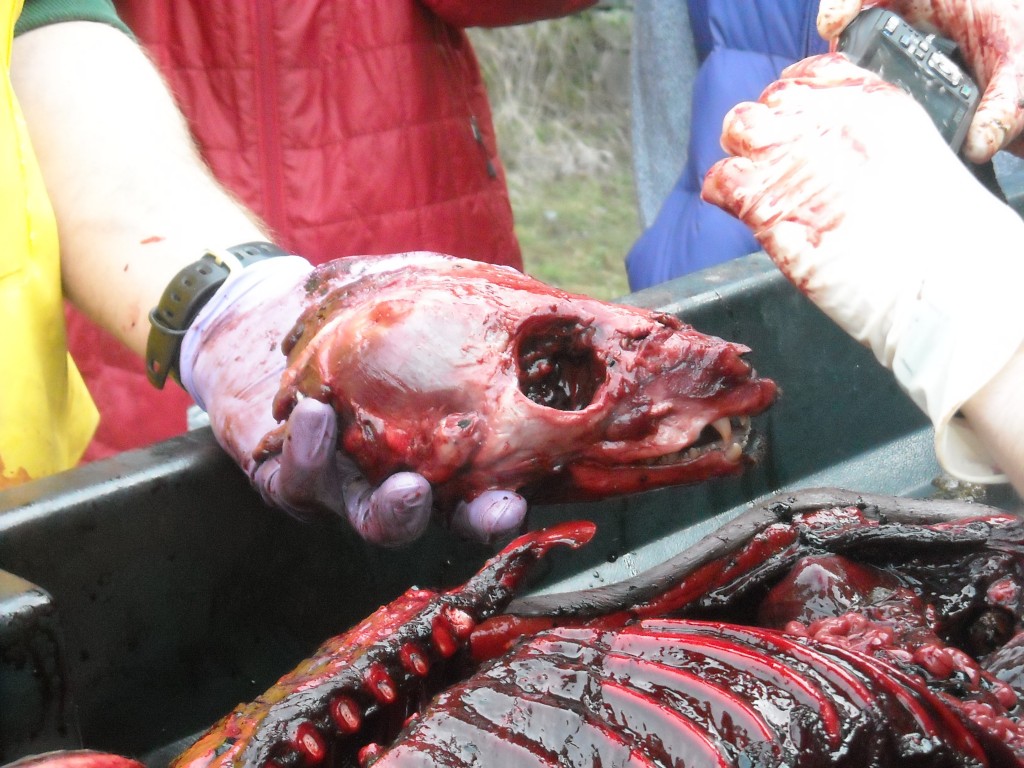
Harbor Seal Skull
Throughout the dissection, there was a great deal of education occurring that snagged at my light physiology background. It was fascinating to see each internal part of the seal accompanied by a brief explanation of what role it played in a living animal. I took an unholy amount of photos, as my interest in possibly becoming a marine mammal veterinarian was weighing heavily on my mind throughout the necropsy. I was bummed that we were unable to stay for the next necropsy candidate, a river otter, but I am so enthused about being able to have such an awesome experience!
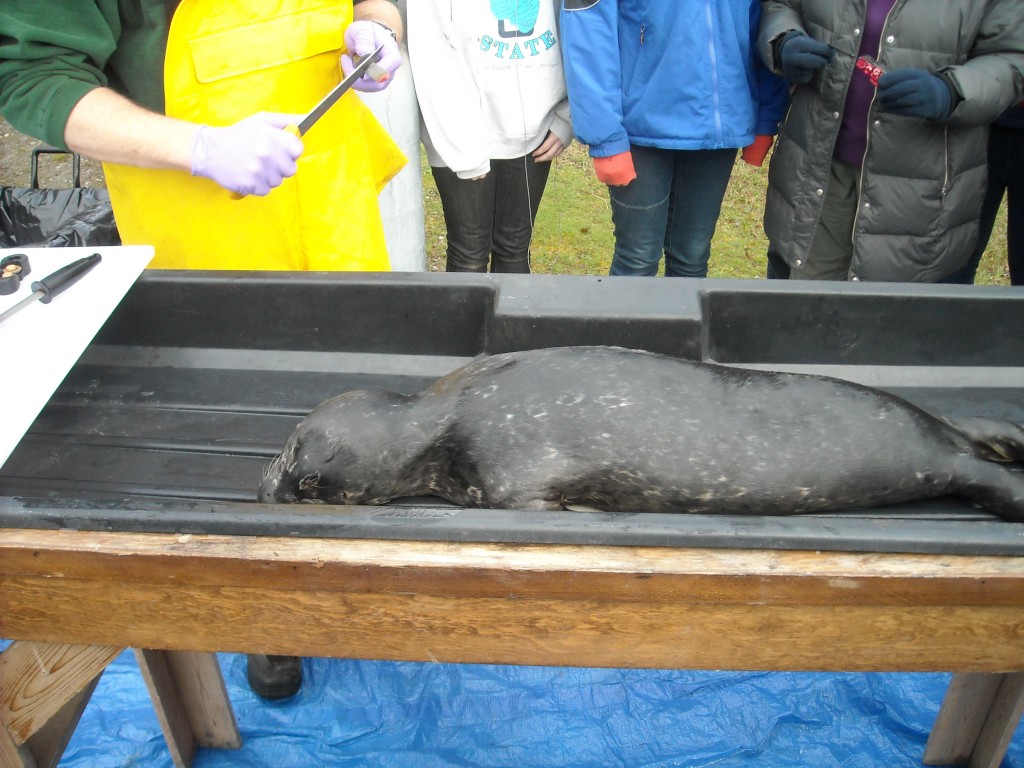
Just Before the Necropsy
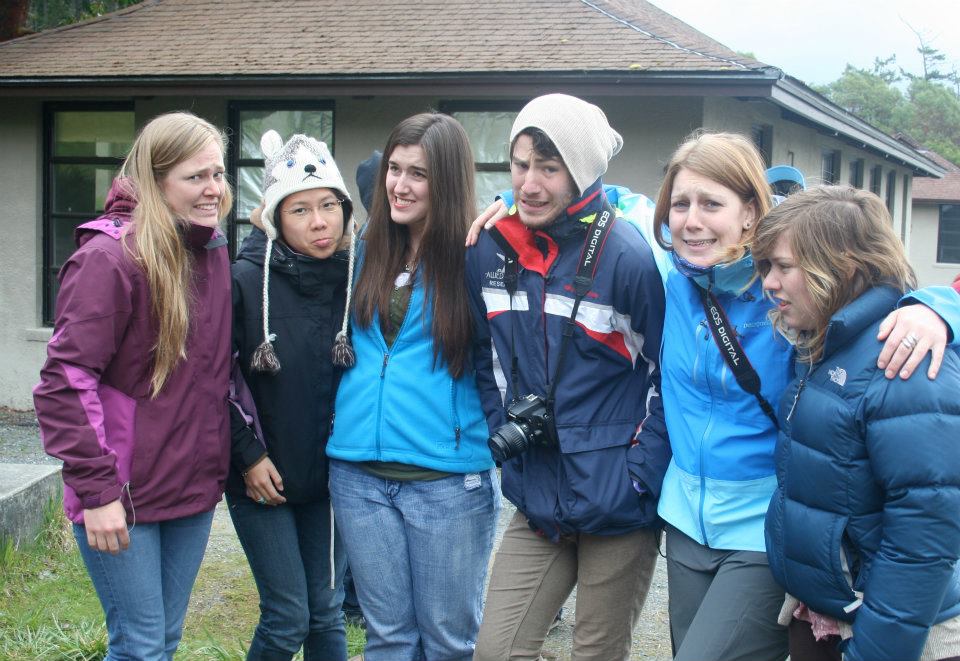
We Survived the Necropsy
Our mid-week adventure to South Beach was tremendous! South Beach, as you may have assumed from the name, is on the South end of San Juan and encompasses American Camp, which is basically the same thing as English Camp, but where the Americans settled so many years ago. It hosts an array of creatures that we were very fortunate to see, from tremendous terrestrial animals, like foxes and bald eagles, to amusing sea birds and harbor seals. The weather was fabulous, sunny and calm; it was optimal marine mammal viewing weather! Unfortunately, the whales were still being rather evasive and we didn’t spot any out in the water.
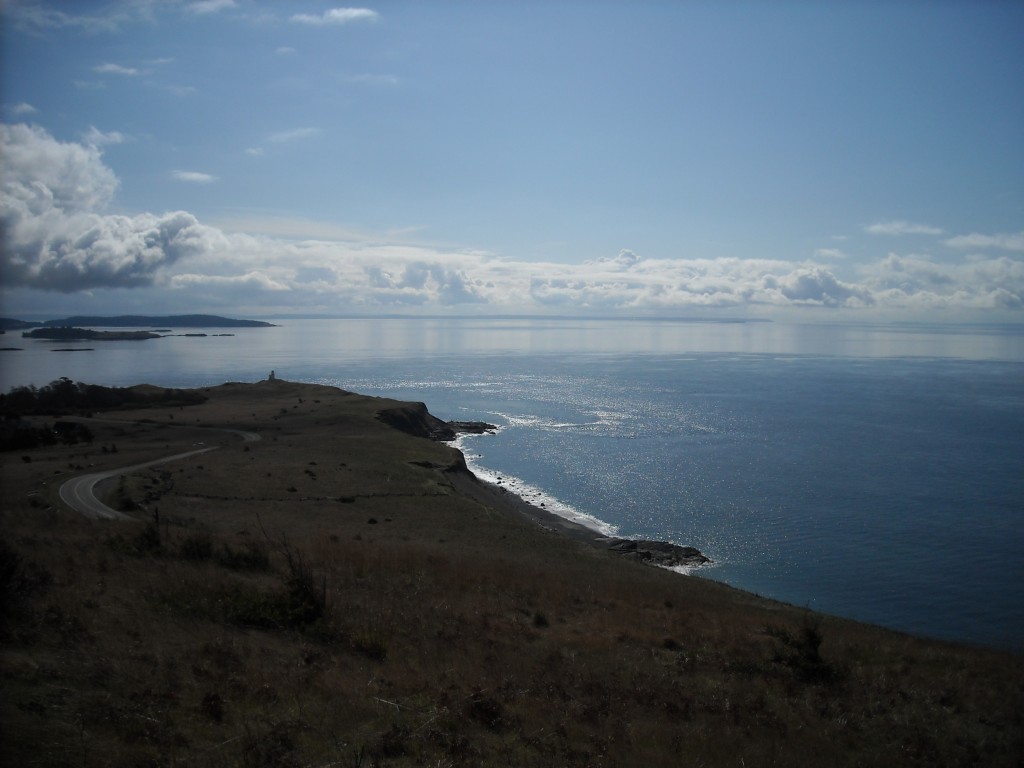
A view of South Beach
Our class time and studies have been enabling us to learn a tremendous amount about the ocean and its incredible inhabitants. I read another case study that dealt with the question of whether or not marine areas protected for ecosystem conservation are compatible with marine areas designed for fishery sustainability. The study focused on the importance of the sea otter’s role in the ecosystem and its relationship to the harvested red abalone, its main source of food, and how the red abalone population was being affected by the sea otters, sustainable harvesting, or both. The results of the study indicated that the sea otters were more detrimental to the red abalone than sustainable, recreational harvesting. When both factors were observed occurring in the same area, the red abalone population was affected adversely. Therefore, it was determined that ecosystem conservation and sustainable fishing are not compatible in this specific situation. I found the results of this study to be really intriguing because it ended with a push for another study, to find compatibility of ecosystem conservation and sustainable fishing. It is satisfying when a study results in an expected conclusion, but if it leaves the door open for more thought provoking research, it becomes so much better!
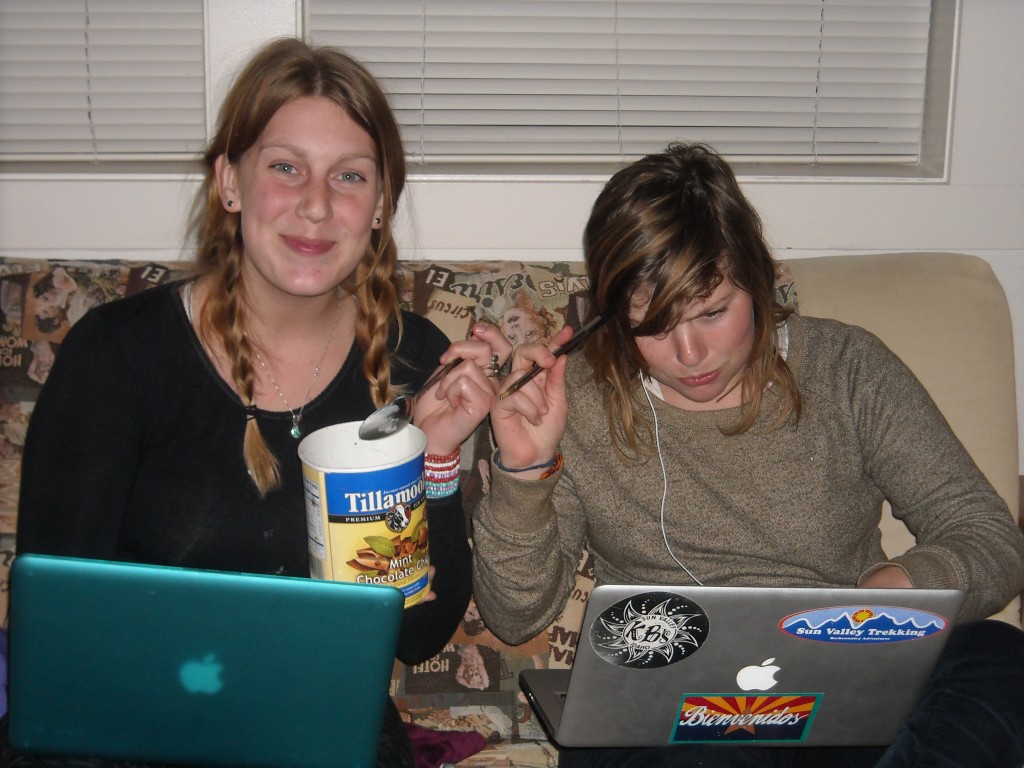
Bre and Jamey hard at work, sitting on Elvis the futon
In our down time, our exploration and discoveries continue! Jamey, Dana and I did a small study of our own. We found that it is difficult to defy gravity and run up a plastic slide on a playground, no matter what type of traction your shoes have. After a try or two, I managed to reach the top of the slide. Difficult it may be, but definitely not impossible! Tomorrow we are going to observe a necropsy on a harbor seal and I am so excited! The food is still delicious, the laughter is ever-present and I am still extremely content in my new favorite place, the San Juan Islands!
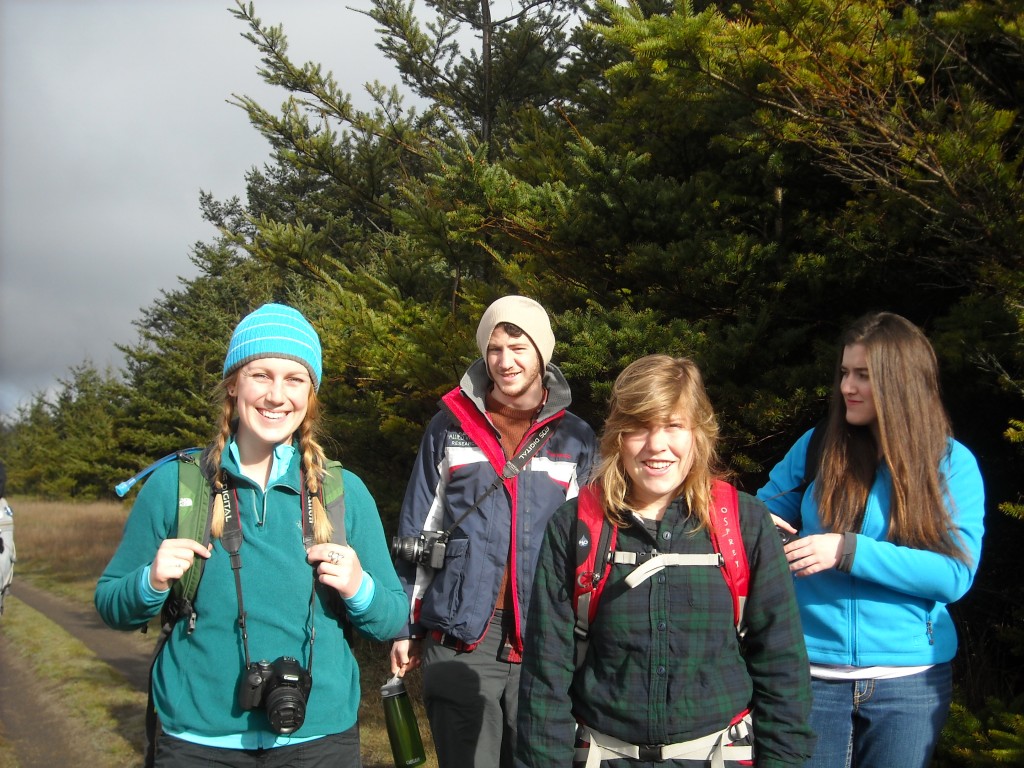
Bre, Phinn, Jamey, and Dana at South Beach where the trees smell like Christmas
Read More
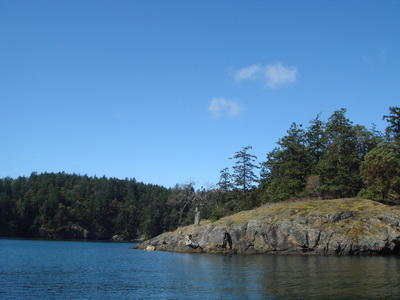
How did San Juan Island really look like 200 years ago?
Last Friday the S Pod had a case study discussion on sustainability. I chose an article entitled “Global Consequences of Land Use” by Foley et al, published in Science in November, 2005. The article pertains primarily to the effects of agricultural land use on land cover. One aspect I find intriguing is soil salinization, a phenomenon common in agricultural lands. Heavy irrigation of soil, coupled with removal of deep-rooted native vegetation, cause water table to rise near to soil surface. A disturbance such as heavy rainfall can then draw water levels to the root zone. When this water is evaporated from the soil surface, the salt is left behind, causing soil salinization, which quickly deteriorates soil quality.
Our Beam Reach instructor, Dr. Scott Veirs, mentioned that one common problem on San Juan Islands is the overwithdrawal of groundwater, causing salt water to seep into the aquifer. This led me to think more about the land and resource usage on San Juan Islands. In a conversation with Jason Gunter, owner of Discovery Sea Kayak, I found out that before English and American settlers arrived at San Juan Islands, the Native Americans practised controlled burning of open lands in order to better harvest bulbs. It has been speculated that at the time, many parts of San Juan Island were not forested. The theory is that controlled burning allowed slow-growing trees such as oak to mature. When controlled burning stopped, tall and faster-growing conifers such as Douglas fir out-competed the slower growing species by creating shades. These conifers propagated, which gradually brought about the landscape we see on San Juan Island today.
Jason has also mentioned that this change in land cover has caused the loss of a few species of birds. It would be very interesting to find out how land use and land cover have evolved for the past 200 years, and whether this has impacted the local nearshore or marine ecology in any way. Nonetheless, I think it is even more pertinent to study the current land and resource usage on San Juan Islands, in order to modify and adapt resource usage to ensure the continuous availability of these resources — such as potable water and fertile soil — in the future.
Read More
After a long week of work we were excited to finally get into town yesterday. We ate a quick lunch, and hopped into the rowboats for a short, and somewhat rambunctious boat ride into Friday Harbor. The Whale Museum was our first, and longest stop. For me the most fascinating part of the museum was the rich cultural connection between the Northwest Coast Native People and the orcas. This subject is of particular interest to me after working at Camp Nor’wester (http://norwester.org/) this past summer. Camp Nor’wester is lucky enough to be home to a native big house, and a Northwest coast Native education program, but until the Whale Museum I didn’t know the native stories of the orcas. After a fascinating hour and half at the museum we decided to mosey around town, and somehow stumbled upon the Sea Shepherd store. For those who don’t know Sea Shepard is an anti-whaling organization founded by Paul Watson. The show Whale Wars follows the organization’s campaigns down in the Southern Sea, where they fight the Japanese whaling fleet. Their methods of stopping the Japanese border on blurred line between eco-terrorism and radical activism, but they do seem to be effective. It just so happened that Peter Hammarstedt, captain of the Sea Shepherd Ship Bob Barker, was doing a meet and greet at the Sea Shepherd store! We got to meet him, and had a really interesting conversation about the role of science in environmental activism (apparently there not much room for it)! This discussion tied in extremely well to our readings and talks in class about sustainability science, and the role science plays in conservation work.
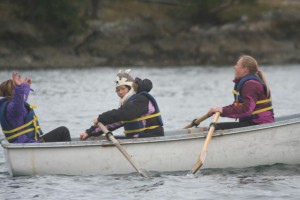
Last week the six of us each presented a case study on sustainability science, and discussed each paper in depth. I presented on a paper titled Rewilding and Biodiversity: Complementary Goals for Continental Conservation by Michael Soule and Reed Noss. This paper discusses the conservation method of rewilding, which aims at creating connectivity between isolated ecosystems. Rewilding is a fairly new technique used by conservation biologists to help preserve the key stone species, which typically are large carnivores, of isolated ecosystems. The concept of rewilding evolved from the theory of Island Biogeography, which was developed by Robert H. MacArthur and Edward O. Wilson in the late 1960s. Island Biogeography is he basic ecological concept that on any isolated environment (originally islands) the ecosystem has a maximum capacity of established species it can hold. The smaller the environment the less species it can sustain, and the higher the extinction rate. Because civilization has built up around many ecosystems, and essentially turned them into ecological “islands†the extinction rate has become much higher in these areas of isolation. Rewilding aims to reconnect these “islands†through wilderness corridors. These wilderness corridors are essentially highways of untouched land through which animals, namely large carnivores, can travel between.
Overall it has been an amazing first week, and I can’t wait to see what the future holds (hopefully whales!). I feel so fortunate to be in such a beautiful place, learning amazing things, with an incredible group of people!
Until next time,
Jamey
Read More
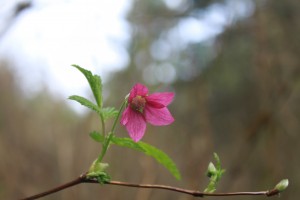
Natural Beauty
After a weekend filled of adventure and excitement I spent most of my Sunday relaxing, reading one of my new books that I found at the great used bookstore in Friday Harbor. Fittingly titled “Serendipity” this quaint little shop stole my heart with its book-filled walls, floors, and ceilings of every imaginable book genre. Despite the draw from the variety of sections, I somehow found myself hunkered down on a stool in front of a shelf full of books on my favorite subject…whales. Before discovering this gem of a shop, my Saturday morning started off with a misty row across the harbor into town. As a group, we wanted to spend our first Saturday adventuring around town together. This of course included visiting the one place we had wanted to go to all week, the Whale Museum.
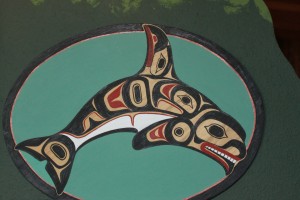
Native Killer Whale Carving
Finding myself wandering around the museum surrounded by hand painted whales swimming across the oceanic walls with the sounds of orca calls filling the air, it finally began to sank in. This experience that I have been dreaming about for years, is finally becoming a reality. I felt like a little kid again, bubbling with uncontainable excitement. That day spent exploring the town, as a group was great. We have already begun to make so many memories here on this enchanted island. The day granted me one more surprise when we ran into an old acquaintance of mine at the movie theatre, Captain Jim Maya. Captain Jim runs one of the local whale watch boats here on San Juan Island. He took my mom and I out whale watching about three years ago. It was the first time I that I saw orcas in the wild, and I will never forget it. I very much attribute my participation in the Beam Reach program to that affirming experience. The phrase “it’s a small world†doesn’t justify our run in with Captain Jim. The sense of community on San Juan Island is incredibly strong. I have a feeling that we will only find ourselves getting more attached to the kind and interesting people that make the atmosphere of Friday Harbor irresistible. Every day I can sense that we are building ourselves a new type of community as a class, and meshing it with the existing one of Friday Harbor.
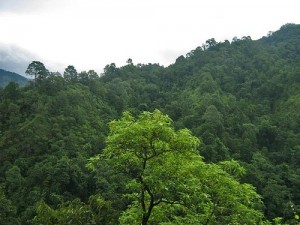
Nepalese Forest Ecosystem
My favorite aspect of the Beam Reach Program is the continuance of my education; we never stop learning, even our break times are filled with academic discussions and inquiries. The other beautiful part of this program is the power the individual student is given to create our own education. Although the resident orca whales intrigue all of us, we also have unique interests outside of the Beam Reach course. Providing us with an opportunity to share those interests with the class, our assignments often ask us to choose journal articles for group discussion. The common thread among all of the articles being that they involve or discuss the practice of sustainable science. When thinking about a case study that I was personally interested in learning about, I instantly thought of Nepal and my hopes to travel there next spring to study community forestry and sustainability. Fittingly, the paper that I chose to discuss with the class is “Capital Formation and Community Forestry in Nepal”. Community forestry in Nepal has become a vital thread of sustainability and environmental conservation. This paper examined the role that capital formation plays in the community forestry process. Specifically, it looked into what characteristics determine the success of a Forest User Group, the title of the community forestry groups, what the generated capital is used for, and the affect this has on the community’s views of the forestry system. What the study found was that the management of their sales, and the type of forest they were managing determined the success of a Forest User Group. In almost all examined cases, the generated capital was primarily used to benefit the community in education.

Coastal Community
Overall, a positive change in attitude towards the system of community forestry was also demonstrated. I feel the paper really demonstrates that giving power and responsibility of the local environment to the community that it affects results in  benefits for the community, as well as improved conservation of the environment. I feel that community management methods are incredibly sustainable, and although the transition period may be difficult if they are given the proper skills, the outcome will outweigh any costs. Reading about the success of community resource management in Nepal got me thinking about community resource management in the San Juan Islands. This community cares a great deal about the local environment and the ecosystems that keep it pristine. I can’t help but wonder what the state of the herring, salmon, orca, and other marine animals would be if community resource management were implemented. Would they be in a better or worse state than they are today? It is hard to say, but I hope to think about this more as the weeks progress. The week ahead promises more mind expansion with multiple guest scientists visiting and lots of afternoons spent out at Lime Kiln Lighthouse.
Read More
A week has already gone by since we moved into Friday Harbor and we have been keeping busy with class and continuing our discussions on sustainability. In my reading I came across a really interesting paper called  Sustainable resource management coupled to resilient germplasm to provide new intensive cereal-grain-legume-livestock systems in the dry savanna. Try saying that 5 times fast. Although it seems a bit daunting its a really fascinating concept. In sub-saharan Africa people are dealing with increasing populations and demand for products while still restrained by the arid climate. After years of research from the ITA (Institute of Tropical Agriculture) researchers found that farmers were hesitant to implement potentially costly technologies without seeing immediate economic profits.
So the focus for the last 10 years has been on cereal-legume and crop-livestock systems where farmers make most of their money. After developing and testing several ideas researchers found the following to be most successful and profitable. They used promiscuous soybeans and dual-purpose cowpea lines which are more efficient at fixing nitrogen. Now don’t worry, its been a while and I wasn’t even sure about the definition of nitrogen fixation, I had to look up. It is the process of changing the structure of nitrogen in order to  free up nitrogen atoms so that they can freely interact with other chemicals. This is important because nitrogen is needed to biosynthesize the basic building blocks of plants. So more efficient nitrogen fixation results in greater crop production. Another problem farmers are facing is a weed called striga which is killing their crops. A soybean they have been working with is able to bring the striga to premature “suicidal” germination. After implementing these two ideas on several farms, farmers saw immediate results. On average crops showed a $1,233 dollar increase per hectare of crop. I think it is very cool that scientists and farmers were able to work together and mitigate a specific problem using crops they already had. By understanding the properties of crops they were able to develop a rotation system to maximize profit.
We’ve been continuing our work on sustainability but are now starting to branch into the research aspect of our course. Over the weekend we put together data sheets for gathering data at Lime Kiln this week and the next. hopefully our luck seeing the Orcas will improve. At the moment we’re working on designing some sort of whale song and dance to call the whales to us, since telepathy hasn’t been working. Either way it’s going to be an exciting week at Lime Kiln.
Read More
It seems like the fun never stops! Our first weekend on San Juan Island was fun-filled and packed full of adventure. The group decided to stay relatively local and explore the quaint town of Friday Harbor. Friday Harbor, although on first sight may look relatively small, in fact has many stores, parks, and of course a beautiful ocean front waiting to be explored. Because the weather looked promising we decided to take a fifteen minute row into town. This gave us an opportunity to see the island from the water; whetting our appetite for the weeks to come.  You get a completely different perspective from being in a little row boat among the larger, and might I add, fancier sail boats. Given our energy and enthusiasm, we headed straight to the whale museum.  The Friday Harbor whale museum is dedicated to promoting whale and environmental stewardship through a variety of displays, artifacts, and presentations. What a fantastic resource we have right on our door step. One of my favourite exhibits was the ‘whose your daddy?’ display.  I particularly appreciated having a visual of the matrilineal lines within the southern resident community (as genealogy often gets confusing). In addition to visiting the whale museum, we were able to wander around town. I loved discovering a used book shop called ‘Serendipity’ (it certainly lived up to its name). It was like walking in a cave of books—piles of books stacked from floor to ceiling. I could have spent hours looking through the, hundred or so, shelves.
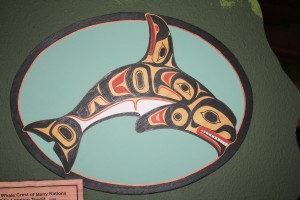
Odin Lonning Tlingit- Killer Whale Crest of many nations
Throughout the weekend, I have continued to contemplate the concept of ‘sustainability science’, and the things I can do, in my research, to become a more conscious scientist. In light of this, the class calculated the total amount of energy consumed from five everyday objects. Given we will be living on the Gato Verde in a few weeks, energy consumption is an area we all need to be mindful of. In addition to this exercise, one of the assignments from the latter part of the week provided some food for thought. We were required to find a paper/case study on any topic of interest, as long as it fell within the sustainability science realm. I chose to research fisheries with a focus on community-based management. Last year I took a class on marine policy, and took a particular interest in community-based fisheries management as a way of promoting alternatives to centralized systems. My paper titled ‘The Context of Policy Design for Existing Community-based Fisheries Management Systems in the Pacific Islands’  looked at community-based fisheries management in a number of small Pacific Islands including Papua New Guinea, Vanuatu, and the Solomon Islands. My paper was very informative in terms of providing the reader with a good overview of national policy and highlighting some of the obstacles associated with implementing such a system. However, because the paper lacked data, it was challenging to analyze existing management schemes in relation to population trends of various species. If I was to continue with this project I would make every effort to collect data to be used as evidence to support this alternative approach to fisheries management. One thing I will take away from the paper is that there is a need for interdisciplinary research that combines human ecological, biological, and economic approaches. Interestingly, Bre’s paper also chose to focus on community-based management (this time regarding forestry in Nepal). Many parallels could be drawn between both our papers.
On a separate note we, as a group, have started to create our own data sheets for the research to be conducted at Lime Kiln. Over the next few weeks, we are going to be looking specifically at marine mammal, sea bird, and vessel abundance (and behaviour). Although the proposed data sheets are still in draft form, we are confident that they cover an array of potential observations. In preparation, we had a ‘birding lesson’ today with Jason Gunter. Despite the windy conditions, we were fortunate enough to see many Bald Eagles, in addition to a few Oyster Catchers, and the odd Cormorant.
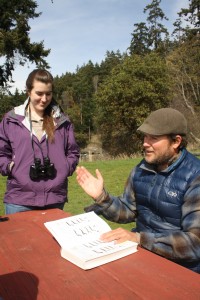
What bird is it?
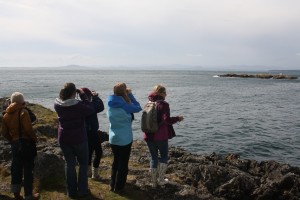
Avid bird watchers in action
The close of a highly educational and enlightening week brought with it the start of our first weekend here in Friday Harbor! I wasn’t really sure how much better my experiences here on the island could get since everything that has happened so far has been more than I expected, but I can see clearly now that my adventures have only just begun. Thursday night, we ventured to the opposite side of the island (near Lime Kiln) to a place called English Camp with a group of other students from the labs. The story behind English Camp resulted from a rather daring pig encroaching upon American crops. Supposedly, some hostility arose between the British and the Americans after the pig demolished a few crops and was killed for trespassing. Thus, a fight broke out and the island of San Juan was forevermore considered American soil. What an extremely silly pig!
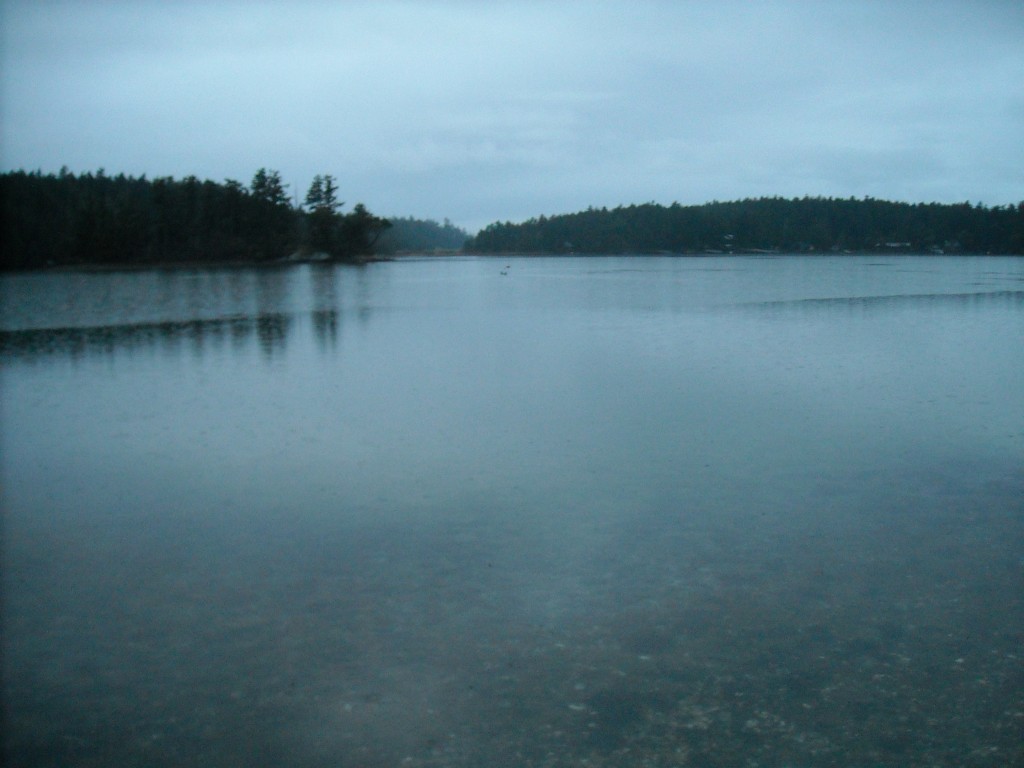
English Camp's ocean view
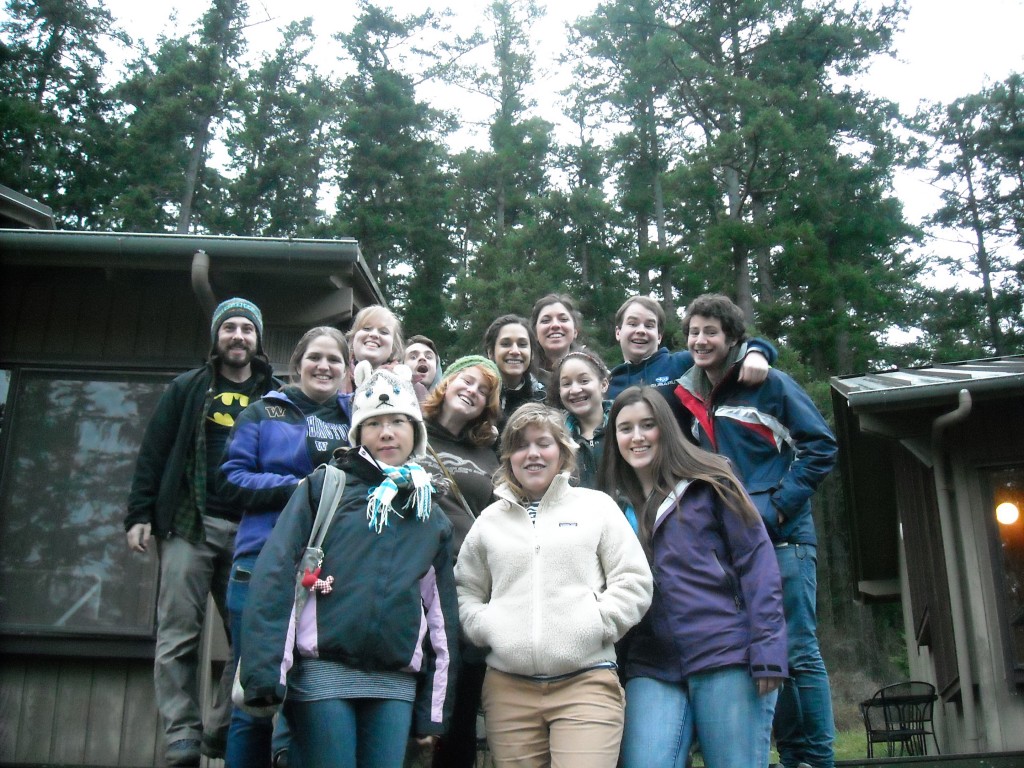
New friends!
Friday’s class opened with a group discussion on different case studies we each chose to read and present. The studies focused on sustainability science, but instead of encompassing the subject as a whole, they honed in on specific examples of the science in action. The study I chose looked at improvements experienced by farmers in developing countries after they adopted more sustainable farming practices, based on a response to a mail survey. It was titled Reducing food poverty by increasing agricultural sustainability in developing countries. It was interesting to find that with subtle changes like soil health improvements, using water more efficiently, and either decreasing or eliminating pesticides completely, the increase in per hectare food production was 93% (a hectare is about 100 acres)! The study took place in developing countries in Asia, Africa, and Latin America, so in order to ensure economical and social support, the changes that occurred encompassed low costs and local availability. I am still a little bit skeptical of the results of the study because they were based on a mail survey and feel that there could have been more accurate results if the data had come from scientists actually in the field, but it was still cool to see such a dramatic improvement.
After class on Friday, the six of us rowed to town (I am still trying to convince myself that this is real). We wanted to stock up on ice cream and cookie dough for our future movie nights! When we returned, we happened upon an exciting gathering in the dining hall. There were quite a few students socializing with fun music and games and it was great to get to know everyone from all of the different programs that the labs have to offer.

Learning to Row
Today (Saturday, March 31), we rowed to town again to explore the Whale Museum and to see the Hunger Games. The Whale Museum was a fantastic place to brush up on and review my knowledge of a few things we learned in class this past week. After visiting the museum, we meandered through town and came across all sorts of fun little shops, like a used bookstore called Serendipity, where I purchased a book called The Life of Pi. I have always been really picky about buying used books, but I couldn’t risk never knowing the survival story of a boy and a tiger. More importantly, I feel like I have made a small step in advancing my sustainable lifestyle. On a different note, The Hunger Games was very intense! I think it really did justice to the book and I can’t believe how much I can’t stop thinking about it. I am glad I was able to share these experiences with my new friends. After all, every adventure is better when you are in good company!
Read More













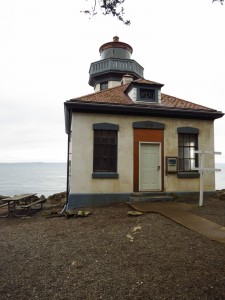








 Twitter
Twitter LinkedIn
LinkedIn Facebook
Facebook